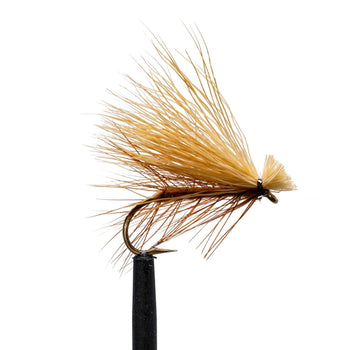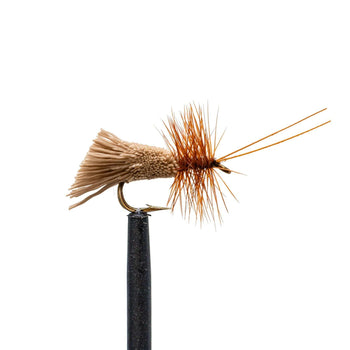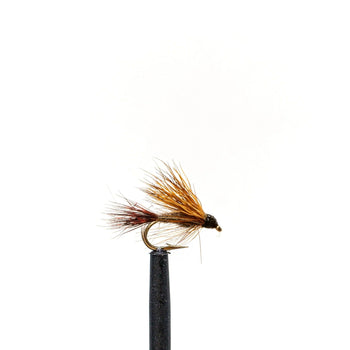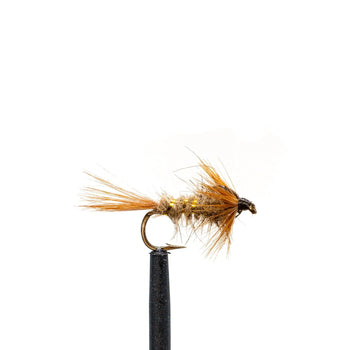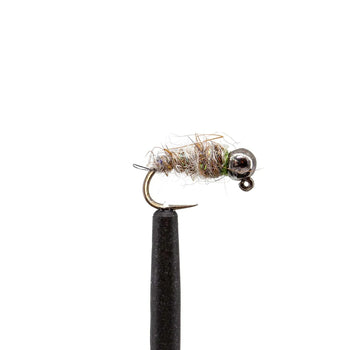As May unfolds and the waters start to warm, it's time to gear up for one of the most exhilarating hatches of the year: the caddis fly emergence known as the Mother's Day Caddis Hatch. This annual phenomenon heralds the emergence of caddis flies in abundance, captivating anglers and trout alike with its spectacle of nature.
Named for its coincidence with Mother's Day weekend in many regions, this hatch truly brings rivers to life as millions of caddis emerge and take flight. Trout eagerly rise to feed on these insects, creating a mesmerizing dance on the water's surface. However, the hatch presents both opportunities and challenges. Trout focus on adult caddis patterns, but unpredictable weather can affect fishing conditions. Anglers must be adaptable with the right flies and techniques, whether fishing lower or higher elevation waters.

Tactics for Success:
-
Observation is Key: Before wading into the river, take a moment to observe the hatch. Pay attention to the size, color, and behavior of the caddis flies. Are they skittering across the surface, or are they riding the currents with ease? This information will guide your fly selection and presentation.
-
Match the Hatch: Armed with knowledge from your observations, carefully select a fly pattern that closely resembles the natural caddis flies. Classic patterns such as the Elk Hair Caddis or the Goddard Caddis are often go-to choices during this hatch.
-
Presentation Matters: During the peak of the hatch, present your dry fly patterns with precision and delicacy. Aim for a drag-free drift, allowing the fly to ride naturally on the water's surface. Focus on likely feeding lies such as riffles, seams, and eddies, where trout are most likely to be found.
-
Skating and Twitching: As caddis flies struggle to take flight, they create surface disturbance that can trigger aggressive strikes from trout. Experiment with skating or twitching your fly across the surface to mimic this behavior. The resulting commotion can be irresistible to hungry fish.
-
Timing is Everything: While caddis hatches can occur throughout the day, the evening hours often yield the most intense activity. Plan your fishing trips accordingly, and be prepared to stay out until dusk, when the hatch reaches its crescendo.
Essential Caddis Adult Patterns:
-
Elk Hair Caddis: A timeless classic, the Elk Hair Caddis perfectly imitates the silhouette of a caddis in flight. Its buoyant elk hair wing makes it ideal for skating across the surface or dead-drifting through riffles and runs. This pattern is versatile and effective in a variety of water conditions, making it a staple in any angler's fly box.
-
Tentwing Caddis: With its distinctive tent-shaped wings, the Tentwing Caddis creates a realistic profile on the water's surface, making it irresistible to trout during a hatch. The silhouette and natural movement of this pattern make it a go-to choice for anglers targeting selective trout in calm water.
-
Goddard Caddis: Named after its creator, John Goddard, the Goddard Caddis features a deer hair body and wing, providing excellent floatation and visibility. This pattern is particularly effective in rough water or during periods of heavy caddis activity when trout are aggressively feeding on the surface.
-
Brown Caddis: Mimicking the natural coloration of many caddis species, the Brown Caddis is a versatile pattern that can be effective in a variety of water conditions. Its realistic appearance and subtle movements make it a reliable choice for imitating natural caddis behavior during a hatch.
-
Bucktail Caddis: Incorporating bucktail fibers for added movement and realism, the Bucktail Caddis is a favorite among discerning trout. This pattern excels in fast-moving water, where its lifelike appearance and action can trigger aggressive strikes from hungry fish.
-
Deer Hair Sparkle Caddis: With its sparkling body and buoyant deer hair wing, the Deer Hair Sparkle Caddis shines in both fast and slow-moving water. This pattern is highly visible to anglers and trout alike, making it an excellent choice for fishing during low light conditions or when targeting aggressive feeders.
Emerger Patterns (for earlier in the day):
-
Elk Wing Emerger: The Elk Wing Emerger mimics the stage of a caddis fly just before it emerges from the water's surface. Fish this pattern with a dead drift just below the surface film to imitate a vulnerable insect struggling to reach the surface. This can be particularly effective earlier in the day when caddis are still in the process of emerging.
-
Hare's Ear Nymph: The Hare's Ear Nymph is a versatile pattern that imitates a variety of aquatic insects, including caddis larvae. Fish this pattern on a nymph rig with a dead drift along the bottom of the river or in slower currents where trout are actively feeding on subsurface insects.
-
Walt's Worm: Walt's Worm is a simple yet effective pattern that imitates a variety of aquatic insects, making it a go-to choice for anglers during a caddis hatch. Fish this pattern with a dead drift along the bottom of the river or in deeper pools where trout are feeding on emerging insects.

Techniques for Fishing Caddis Patterns:
-
Dry Fly Drifting: During the peak of the hatch, present your dry fly patterns with a drag-free drift, mimicking the natural movement of the caddis on the water's surface. Keep an eye out for rising fish and target likely feeding lies such as riffles, seams, and eddies.
-
Skating: As caddis flies struggle to take off from the water's surface, they create surface disturbance. Mimic this behavior by skating your fly across the surface, enticing aggressive strikes from hungry trout.
-
Dead Drifting Emergers: As the hatch progresses, trout may become more selective, focusing on emergers just below the surface. Present emergers like the Elk Wing Emerger or Hare's Ear Nymph with a dead drift, using a small amount of floatant to keep them riding just below the surface film.
-
Swinging: In faster currents, try swinging your caddis pattern across the water's surface, imitating an egg-laying female caddis. This method can be particularly effective during the later stages of the hatch when trout are keying in on spent adults.
Experiment with different presentations and patterns until you find what works best on any given day. And remember, the key to success during a caddis hatch is observation and adaptability. Tight lines, and happy Mother's Day fishing to all the angling moms out there!
RELATED ARTICLES:




